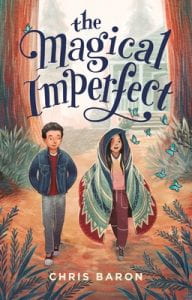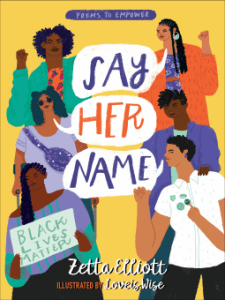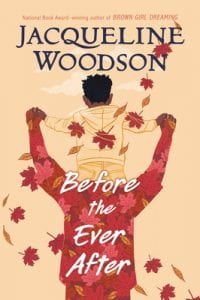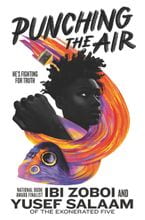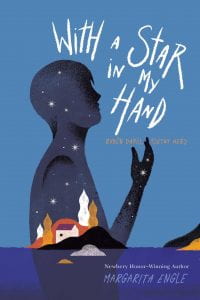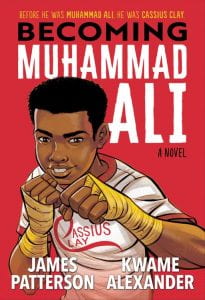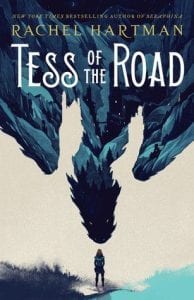
Hartman, Rachel. Tess of the Road. New York: Random House, 2018. 978-1-101-93128-8. 536 p. $18.99. Gr. 8 and up.
Rachel Hartman’s latest epic tome (it’s a whopping 536 pages), Tess of the Road, follows Tess Dombegh on her road to self-discovery and self-reflection. Tess feels trapped: trapped by her past and her future; trapped by her upbringing; trapped by family obligations. After nearly ruining her twin sister Jeanne’s wedding by drunkenly confessing a family secret to her new brother-in-law, Tess, without much forethought, runs away. The novel takes place in the same world as Seraphina; indeed, Tess is Seraphina’s half-sister, but only grudgingly. Unlike Seraphina, however, which focuses mainly on court and Dragon politics, Tess of the Road is a much more introspective novel, and puts the focus squarely on Tess herself. Quickly, Tess realizes that a woman traveling alone is a dangerous prospect, so she disguises herself as a boy, adopting the persona of her loathsome brother-in-law, Jacomo, a burgeoning monk. She serendipitously finds her long lost childhood friend, Pathka, a Quigutl (not quite a dragon, not quite a human, not quite a lizard), and the two set off together on something like a pilgrimage to find a World Serpent named Anathuthia, a legendary snake like creature who helped shaped the world. As she travels, the reader gets glimpses into Tess’s heartbreaking past, which involve a rake named Will, and her reasons for wanting to be on the road become ever clearer. The people she meets along the way reframe her idea of herself – she was raised to hate her own body, to believe that a woman is the embodiment of sin, and that her only duty is to her husband and family; Tess’s realization that she can be more than her mother has always suggested she is (which isn’t much) is one of the joys of this book. Tess is not always a sympathetic character, and she makes plenty of missteps, but her intentions are almost always honorable, and she does her best to make up for those she wrongs. This is not a fast-paced, action-packed novel – it is a slow, cathartic, reflective journey, but those who reach the end will be well-rewarded.
THOUGHTS: Rachel Hartman’s secondary characters are supremely well-rounded, and Tess’s interactions with each of them, especially her sister, Jeanne, with whom she has a not so healthy relationship, Tess’s brief, enlightening encounter with Frai Moldi, an angry, depressed, and brilliant young monk, gives this novel such depth. Just when you think you know exactly who each character is, and how they’ll react in certain situations, they throw you for a loop, and defy expectations.
Fantasy Lauren Friedman-Way, The Baldwin School

Safi, Aminah Mae. Not the Girls You’re Looking For. New York: Feiwel and Friends, 2018. 978-1-250-15181-0. 331 p. $17.99. Gr. 9 and up.
Aminah Mae Safi’s Not the Girls You’re Looking For reads like an angrier, edgier cross between Jenny Han’s To All the Boys I’ve Loved Before, and E. Lockhart’s The Boyfriend List. While this isn’t the most sophisticated novel, it is an important one, as it celebrates female sexuality; each of the female characters actively and unabashedly experience sexual desires and are intimately involved with others. That being said, it also doesn’t beat around the bush about how others perceive female sexuality, and the word “slut” is bandied about quite a bit here. Our protagonist, Lulu, is in the midst of something of an existential crisis: she is half White and half Persian, and feels like she doesn’t truly belong anywhere – her mother’s family has rejected her father and his family, and her father’s family will not fully embrace her mother, or Lulu. She has experienced racism and Islamophobia at the hands of her classmates, and it drives her decision to stay under the radar socially (which hasn’t actually seemed to work too well). Despite this, Lulu has a loyal and fierce group of friends – Lo, beautiful, intimidating, and smart as a whip; Audrey, posh, wealthy, and polished; and Emma, the reserved peacekeeper of the group. They are not always a likeable or sympathetic bunch, but they truly love each other, even when they’re horrible to each other. When Lulu’s friendships begin to splinter for various reasons, she has to come up with a plan to bring them all back together again. In the meantime, she also has to navigate a somewhat tempestuous new romance, an obnoxious male classmate who won’t stop making unwanted advances towards her, birth control, and Ramadan. While the writing here can be disjointed and awkward at times, readers will instantly find themselves enraptured with Lulu and her world.
THOUGHTS: This is definitely a book for more mature readers. However, this novel realistically portrays burgeoning teenage sexuality; the discussion Lulu has with her mom about sex is particularly affecting, and will be helpful for teens looking for a way to open up a dialogue with their own parent, or with a trusted adult, about the topic.
Realistic Fiction Lauren Friedman-Way, The Baldwin School
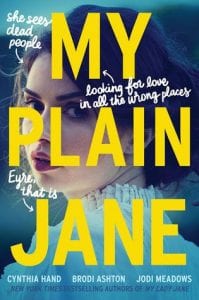
Hand, Cynthia, et al. My Plain Jane. New York: Harper Teen, 2018. 978-0-062-65277-5. 450 p. $17.99. Gr. 8 and up.
My Plain Jane is a charming, effervescent, and witty retelling(ish) of Charlotte Bronte’s Jane Eyre. In this reimagining, Cynthia Hand, Brodi Ashton, and Jodi Meadows, Bronte and Jane Eyre are close friends at Lowood School, where Jane Eyre is a teacher. In this version of the story, Jane Eyre is a “seer,” which means she can see, and communicate, with ghosts. Indeed, Helen Burns, her best friend who passed away from “graveyard disease” at the age of fourteen, is her constant ghostly companion. Jane keeps this a closely guarded secret, however, as it has only caused her grief when she’s tried to tell people about it. Enter Alexander Blackwell, a member of the Society for the Relocation of Wayward Spirits (SRWS), an organization run by the Duke of Wellington that has fallen out of favor with the king, who does not believe in ghosts. When he comes to a pub close to Lowood to “relocate” a troublesome ghost, Jane witnesses this event, which entails Alexander “bopping” the ghost on the head with a pocket watch. When Alexander discovers that Jane is a seer, he sets out to recruit her for the SRWS. She wants nothing to do with it, as she has decided that it’s an evil organization who imprisons ghosts for nefarious purposes; instead, she takes a position as governess at Thornfield Hall. Not one to give up so easily, Alexander, with the help of Charlotte, who would give her left foot to join the SRWS, and Branwell, Charlotte’s brother, and the newest, albeit bumbling, member of the SRWS, pursue Jane to Thornfield to attempt to persuade her to join up. Jane, however, has fallen hard for the mysterious, erratic, and shifty Mr. Rochester, whom nobody trusts, least of all Helen, who is convinced there is something terribly wrong at Thornfield, and with Rochester. We all know what happens next, right? Actually, no – the story deviates quite a bit here, with a truly supernatural twist. It turns out there’s more to everyone’s story here, Rochester most of all, and Hand, Ashton, and Meadows do a wonderful job creating a clever alternate ending. While it helps to have some knowledge of Jane Eyre, and Charlotte Bronte, just to understand some of the references, it’s not necessary to enjoy and appreciate this rolicking ghost story.
THOUGHTS: This is the second “Jane” novel that these three authors – they have dubbed themeselves The Lady Janies – have co-penned; the first, My Lady Jane, was an alternate take on Lady Jane Grey’s story. Sadly, readers will have to wait at least two years for the next Jane story – My Calamity Jane. Be sure to have copies of Jane Eyre, and other Bronte novels, on hand for readers of this book!
Historical Fantasy Lauren Friedman-Way, The Baldwin School
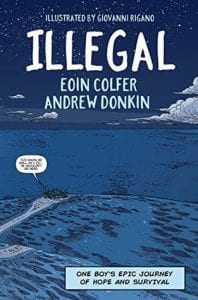
Colfer, Eoin, and Andrew Donkin. Illustrated by Giovanni Rigano. Illegal. Sourcebooks Jabberwocky, 2018. 978-1-492-66214-3. 128 pp. $19.99. Grades 6-12.
Illegal follows the perilous journey of Ebo, a twelve-year old boy from a small village in Ghana, to a potentially brighter future in Europe. Realizing that his older brother Kwame has already fled their village, Ebo follows him to Agadez, Niger. Reunited, the brothers travel across the Saharan Desert to the city of Tripoli, Libya, where they work tirelessly to save enough money for an ocean crossing to Italy. The boys are continuously confronted with harsh elements, unsympathetic authorities, and unscrupulous traffickers, but Ebo’s ingenuity and drive may see them safely through. Authors Eoin Colfer (of Artemis Fowl fame) and Andrew Donkin employ a dual timeline, depicting the hazardous boat voyage across the Mediterranean (“Now”) in alternating chapters with the nineteen months Ebo spent getting there (“Then”). This effective structure illustrates how Ebo’s path involves not just one dangerous crossing, but many months of risk, fear, and luck – sometimes good and sometimes bad.
THOUGHTS: Ebo’s story is fictional, but each element of his journey is based in fact. Brilliantly colored artwork and an emotionally gripping storyline bring the humanity of an “illegal” to life for readers of all ages. Escape from Syria by Samya Kullab is another excellent graphic novel about the refugee experience for readers seeking a comparable title.
Graphic Novel Amy V. Pickett, Ridley SD
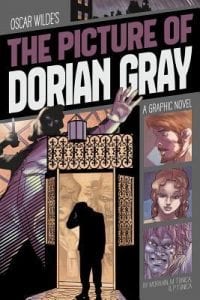
Morhain, Jorge, Martin Tunica, and Pablo Tunica. The Picture of Dorian Gray: A Graphic Novel. Stone Arch Books, 2018. 80 p. 978-1-496-56409-2. $27.32. Grades 7-12.
The strength of this book is Oscar Wilde’s thought-inspiring story wherein the virtuous, wealthy, and handsome Dorian Gray is painted by Basil Hallward, and so showered with praise that Dorian impetuously wishes to sell his soul if he can always appear as he does in the painting. Soon, under the tutelage of the amoral Henry Wotten, Dorian is making one cruel choice after another and realizing that while he does not age, his (now hidden) portrait shows the true ugliness of his soul. In an era where beauty is believed by some to show the purity of the soul within, everyone loves Dorian. But his reputation is slowly being sullied by rumors. Worse yet, Dorian struggles inside himself to make sense of his own desires. Who is he? Why is he loved? Can he truly do anything he wishes? By believing something, can he make it so, or change the truth?
THOUGHTS: This slim graphic novel is scripted by writer Jorge Morhain, with illustrations by Martin Tunica and coloring by Pablo Tunica. Glossary, discussion questions, and writing prompts enrich the reading. It is true that the twists and beauty of the original language are missing, but Wilde’s story stands the test of time and change.
Graphic Novel Melissa Scott, Shenango Area SD
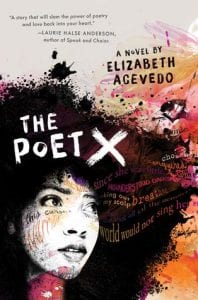
Acevedo, Elizabeth. The Poet X. Harper Teen, 2018. 361 p. 978-006-266280-4 $17.99 Grades 9-12.
Xiomara is a fiery Dominican, full of questions that do not fit with her Catholic mother’s strict parenting style, nor her devout and quieter best friend Caridad or even her own twin Xavier. She finds the treatment of females demeaning (especially one so developed as she is), and her entire community’s expectations (or lack thereof) for her to be restricting and bland. Xiomara has a voice, but using it is proving problematic. Xiomara also has a temper and fists which she uses to fight back, for herself or her smaller, cautious brother. But Xavier sees through his sister, and his gift of a leather-bound notebook to Xiomara on their birthday starts Xiomara to writing. Xiomara writes poetry, expressing the frustration, anger, and confusion she feels about her family, her community and her future. Her English teacher encourages her to attend her new performance poetry club, but it conflicts with scheduled confirmation classes with Father Sean. Refreshingly, Father Sean tells her that questions are allowed and necessary. At school, she begins a relationship with Aman, which fills her poetry with more questions, especially since Mami would undoubtedly rejoice if Xiomara chose the life of a nun that Mami herself was denied at Xiomara’s age. Xiomara disobeys her mother to be with Aman, and to attend the poetry club. Both cause her to grow, but only poetry does not disappoint. “I can’t remember/the last time people were silent/while I spoke, actually listening” (259). Xiomara is hiding her explosive self, and it’s about to unravel. Can she find peace with her family and be true to herself? “If my body was a Country Club soda bottle/it’s one that has been shaken and dropped/and at any moment it’s gonna pop open/and surprise the whole damn world” (105).
THOUGHTS: This is a strongly written first novel, completely in verse, and reveals a complicated young woman seemingly at odds with the world. To witness her transformation–and her family’s–aided by Father Sean, is rewarding.
Realistic Fiction Melissa Scott, Shenango Area SD
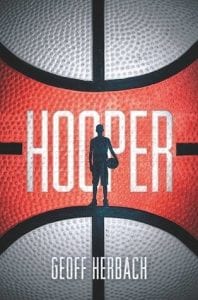
Herbach, Geoff. Hooper. Katherine Tegen Books, 2018. 323 p. 978-0-062-45311-2 $17.99 Grades 9-12.
“Basketball is my passport.” So believes Adam (Sobieski) Reed, since he moved from orphaned poverty in Poland to Minnesota with his adoptive mom (angel) Renata. Soon enough he discovered basketball and a talent for it. “Oh, I love being on the court even if I’m not playing….Everything makes sense to me with basketball….Man, I just want to play” (86-7). He also found his only friend, outsider Barry Roland, and self-centered nemesis Kase Kinshaw, who calls Adam “Duh” or “the Refugee.” Adam’s still-growing understanding of the English language and (especially) American culture places him in some awkward and hilarious situations, which Kase is glad to showcase. Basketball brings Adam hope and, importantly, a friendship with Carli Anderson, who has drive and talent beyond Adam’s, despite tackling a severe knee injury. When Adam joins a select AAU team, he takes Carli’s advice to “talk more” to people, and finds himself a family in which he’s the only white kid. But every family has pressures, and off-court problems threaten this new family, as well as Barry. How Adam seeks to respond to the problems will determine the trajectory of his life and friendships, even his career, for some time to come. Herbach has crafted a likeable, multi-faceted narrator in Adam, and readers will root for him as he learns to navigate America, the “inky black nightmares” from his past, and relationships in a new place.
THOUGHTS: A well-built cast of characters with unique interactions gives truth to the credo, “every person you meet has a story to tell.”
Realistic Fiction Melissa Scott, Shenango Area SD
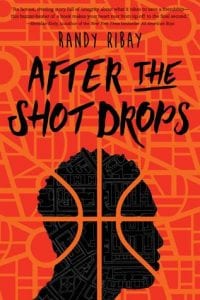
Ribay, Randy. After the Shot Drops. Houghton Mifflin Harcourt, 2018. 325 p. 978-1-328-70227-2 $17.99. Grades 9-12.
Bunny Thompson and Nasir have been best friends for years, but now in their sophomore year of high school, Bunny transfers to St. Sebastian’s, an elite prep school. He has the basketball talent, and they have the opportunities. But Nasir is left behind at Whitman High, and since Bunny never discussed the change with him, he is feeling more than a little resentful of Bunny’s abandonment. “You’re looking out for yourself so hard you forget that everyone else exists. So it’s nothing to you to leave us behind” (125). Nasir is also concerned about his cousin Wallace, who is about to be evicted and whose bad choices have led him into bad places before. Nasir is disappointed that “[Bunny]’s got the world looking out for him. I’m the only one in Wallace’s corner” (139). So Nasir tries to help, but Wallace’s attempts to make some fast cash by betting on Bunny’s games leads him to severe desperation, so much that Nasir asks Bunny to throw a championship game. Nasir realizes, “I don’t know how to help one without hurting the other” (169) and “Maybe it’s time for me to do right by both my friends, not just one” (243). But how to do that is the challenge. Told alternately from Nasir’s and Bunny’s point of view, Ribay allows us to see the challenges each of the three young men face and swallow the frustration each one feels about the limits of their lives. Bunny opens the novel by considering the impact of words in a memorial, and Nasir ends the book wishing he’d have been able to find the words to make more of a difference. This power of words, and the question of personal vs. collective responsibility, drive the book.
THOUGHTS: This is a compelling look at limits, perspective, loyalty and compassion, strengthened by the use of dual points of view. A must-have for high school collections.
Realistic Fiction Melissa Scott, Shenango Area SD
 Schlitz, Laura Amy. Amber & Clay. Candlewick Press, 2021. 978-1-536-20122-2. 532 p. $22.99. Grades 5-9.
Schlitz, Laura Amy. Amber & Clay. Candlewick Press, 2021. 978-1-536-20122-2. 532 p. $22.99. Grades 5-9.
